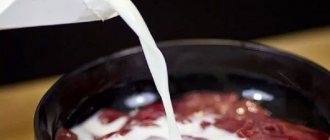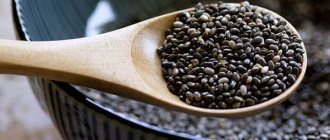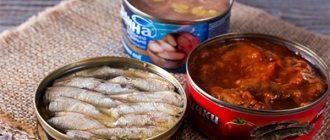How to remove excess salt from sprat?
When all the sprat is put in a container for salting, put pressure on the fish and put it in the refrigerator. After 3-4 hours, the fish can be eaten. After salting, the sprat will release juice. To remove excess salt from fish that has not dissolved, simply rinse the sprat in boiled water.
Interesting materials:
Why are garlic leaves tied? How to quickly dry tree leaves? How to divide leaves into syllables? How to add a new sheet in Excel? How to make violet leaves shine? How long should the leaves be dried? How to use barberry leaves? How to use cilantro leaves? Like a leaf in front of the grass? How to pickle leaves for crafts?
Why do you need to soak herring?
For a long time, fish was very well and abundantly salted for long-term storage. Before use, it was poured with water, tea, and milk to get rid of excess salt and improve the taste. The old recipe is still used today. Milk makes the meat more tender, and strong tea makes it stronger; thanks to the tanning components, the product does not spread or fall apart when cut.
Herring is devoid of carbohydrates and is allowed as part of a diet. But salt is harmful to the body and is excluded from nutrition in most diets. Therefore, for many people, overly salted herring is contraindicated for dietary purposes or it requires soaking.
When purchasing fish made in production conditions, its degree of salting can be found on the packaging:
- 9% – light salting;
- 9-14% – medium salted;
- 14% or more – strongly salted.
Fresh milk is not used with herring, but it is often used in cooking, for example, when baking fish. Soaking herring in milk to remove excess salt will be correct and not harmful to health. There are many recipes for cooking herring with sour cream, mayonnaise, and milk brine.
The simplest and cheapest option is to soak the whole fish in plain water for an hour to two days. For 1 kg you will need 3 liters of liquid, which must be changed every 3 hours. As a result, the fish will become softer and less salty. You can also pour for 2 minutes. herring with hot water and then immediately put into cold water. But this method deprives the product of fat content. This is what you do with lean fish. Herring absorbs different aromas well, and adding vinegar and onions to the water or before soaking will help get rid of foreign odors.
As an additional saving, you can not throw away the insides, but prepare an interesting dish from the milk.
In milk
Milk will help reduce the saltiness, as it absorbs salt and makes the meat white. The herring turns out juicy with a delicate texture. For 1 kg you will need 250 ml of milk. The carcass is first cleaned, cut into fillets, placed in a bowl and filled with milk, which is changed every 3 hours. The container is placed in a cold place.
In vinegar
Prepare the marinade: 1 tbsp. l. vinegar per 1 liter of water. Soak the fish in the resulting mixture for 6 hours, or more if necessary. Acid removes unpleasant odor and makes meat tastier.
In tea
Prepare tea without any additives. Take 1 tsp per 100 ml. Sahara. When the solution has cooled, pour over the fish and leave for 4 hours. Tanning components will not only get rid of salt, but also add a yellowish color and a pleasant aroma.
People's "fake"
In reality, the combination of herring and milk will not cause any explosive effect. Nutritionists claim that none of these products contain substances that can cause a reaction harmful to the human body. Of course, this only applies to quality products. The only reason why such a combination can negatively affect the body is individual intolerance to any component. Lactase deficiency (milk intolerance) or allergy to herring are the only contraindications.
Jewish herring
Forshmak in Odessa is the simplest Jewish recipe, which has deservedly become a national dish. Russian housewives like to prepare this dish. The recipe will not take much time, and you will also need affordable ingredients. It is impossible to over-salt the dish, even if the herring is very salty. A bun soaked in milk adds juiciness and neutralizes the salt, while vinegar and butter add a piquant flavor to the finished product.
- 500 g fish fillet;
- 1/2 cup milk;
- 4 slices of loaf;
- 3 eggs;
- 2 tsp. mustard;
- 2 tsp. vinegar;
- 1 onion;
- 60 ml oil.
Step-by-step recipe with photos:
- Place the loaf in milk to soften.
- Separate the yolk and grind with mustard, add a little oil.
- Grind the onion, fillet, whites and loaf, mix everything and mix with the yolk, pour in the oil and vinegar.
Of course, this is a simplified version of Jewish forshmak, but it’s easy to prepare, spread on a piece of bread and have a snack.
You need to pour fresh milk over the fish; there is no need to boil it.
- Spicy salted fish, fatty, Atlantic and smoked herring are not soaked.
- To save milk, it is diluted with water in the same proportion and poured into the fish.
- You can also use other dairy products, such as whey, kefir, and yogurt.
- If the fish fillet is too soft, you can add vegetable oil to the herring. Place the pieces in a container and pour in oil to cover completely. Place in the refrigerator for a couple of days.
- Onions will help improve taste. Peel the vegetable, cut into half rings, add sugar, salt, vinegar and mash with your hands, then let stand for 10 minutes and add pieces of fish. Onions add a delicious flavor.
What does milk give?
Why is fish soaked for dietary purposes? Herring, like other types of fish, is often used in various diets. Herring is rich in polyunsaturated fatty acids and amino acids, which are not produced by the body. Vitamin D is necessary for the skeletal system, and vitamin A is necessary for vision. But salt harms the kidneys and organs of the cardiovascular system. Soaking herring allows people with problems with the kidneys, heart and gastrointestinal tract to consume the product.
Milk adds a sweet taste and makes the meat tender and airy. The product loses less beneficial properties and remains greasy. Milk removes salt, but adds microorganisms to the fish, which reduce shelf life. Therefore, it is necessary to soak the product immediately before eating.
Soaked dietary herring, recipe
There are different types of fish in the seas, rivers and oceans, but all of them are especially popular among the population.
This product is a source of easily digestible protein and many useful substances: vitamins, minerals and fats. It's nutritious and delicious! Herring enjoys special love among our fellow citizens. A variety of dishes are prepared on its basis and consumed on its own. However, in some cases, ordinary store-bought fish can be harmful to health, for example, if you need to adhere to a diet with less salt. Soaked dietary herring is recommended for such people; let’s look at the recipe for preparing such a product at www.rasteniya-lecarstvennie.ru in a little more detail. How to prepare soaked herring, a recipe for preparing it in different ways
If you are prescribed dietary nutrition, then before consuming herring you must soak it. Before such processing of fish, it should be gutted: remove the scales, as well as the head and entrails. Rinse the carcass and chop it into portions if necessary. The herring must be soaked for a long time - from twelve to twenty hours.
You can use ordinary water to soak fish. Just immerse the herring carcass in it and send the container to a cold place, for example, in the refrigerator. Every two to three hours it is necessary to pour out the liquid that has absorbed the salt. If the fish surfaces, it means that it has lost the required amount of salt. The taste of such a dish will be more pleasant and delicate, but it will absorb quite a lot of liquid.
You can also soak herring using tea or milk. The cleaned fish must be cut along the back into two parts without removing the skin. Dip the carcass into cooled strong tea with sugar or milk. Tea will prevent the herring from becoming soggy and spreading, and milk will add airiness and tenderness to it. To soak such a product in tea, you only need four to six hours.
It is worth remembering that soaking leads to some leaching of proteins, minerals, salts and nitrogenous elements from the fish. This prepared product should only be stored in the refrigerator and no longer than twenty-four hours.
Soaked dietary herring. Beneficial features
It is believed that fatty herring is rich in the maximum amount of beneficial properties. This product is a source of a lot of polyunsaturated fatty acids, which are extremely beneficial for the body. Thus, oleic acid in its composition perfectly optimizes the activity of the heart and blood vessels and has a positive effect on cerebral circulation.
Herring proteins saturate the body with the lion's amount of essential amino acids. Such substances are not produced in our body, which is why we must get them with food.
This fish is also rich in a significant amount of vitamin D, which is necessary to maintain healthy bones and teeth, as well as to activate the body's defenses. It contains a lot of vitamin A, which prevents vision problems.
Herring is also a source of potassium, calcium, cobalt, phosphorus, iron, manganese, copper and iodine.
Consumption of such fish helps improve brain function. It helps remove excess cholesterol from the body, preventing atherosclerosis. It contains a number of antioxidants that can prevent the aging process and the development of cancer. There is evidence that such a food product helps to reduce the likelihood of developing type 2 diabetes by an order of magnitude. Herring has a positive effect on the condition of the skin and even helps eliminate many dermatological ailments, including psoriasis, etc.
When should you soak herring?
Soaking herring is necessary for people who suffer from hypertension, kidney disease, heart disease, as well as the digestive tract and some other pathological conditions. Such patients need to eat unsalted fish and only in small quantities.
Before including this product in the diet for the diseases described, it is imperative to consult with your doctor or nutritionist.
How to pickle herring yourself?
To prepare the marinade for pickling, you need to combine one liter of boiling water with three tablespoons of salt (without top), a couple of bay leaves, three to four peas of allspice and three to four buds of cloves. Stir the brine thoroughly and cool it.
The herring can be salted whole, but you can also cut off its head and remove the insides. After such manipulation, you should rinse the fish in running water.
Place the herring in a suitable container (in a plastic container or in a saucepan), fill it with the cooled marinade, cover with a lid and put in the refrigerator for a day, or even longer.
Herring prepared according to this recipe can be used to create dietary dishes - soak it as described above.
How to choose a herring?
If you are going to salt the fish yourself, give preference to freshly frozen carcasses that are free of creases, bends, dents and abrasions. The fish should be thick on the back, there should be no spots on its skin (rusty or yellow-brown), it should be colored a uniform dark gray color.
If you buy salted fish, pay attention to the gills: they should be dark red without any inclusions. The leather should be free of stains and rust. Of course, herring should not have any foreign odor.
Soaked herring is an excellent product that must be included in the diet for many pathological conditions.











